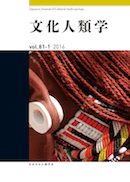Volume 88, Issue 2
Displaying 1-32 of 32 articles from this issue
- |<
- <
- 1
- >
- >|
front matter
-
2023Volume 88Issue 2 Pages f1-
Published: September 30, 2023
Released on J-STAGE: December 29, 2023
Download PDF (284K) -
2023Volume 88Issue 2 Pages f2-
Published: September 30, 2023
Released on J-STAGE: December 29, 2023
Download PDF (640K) -
2023Volume 88Issue 2 Pages 191-192
Published: September 30, 2023
Released on J-STAGE: December 29, 2023
Download PDF (120K) -
2023Volume 88Issue 2 Pages 193-
Published: September 30, 2023
Released on J-STAGE: December 29, 2023
Download PDF (1199K) -
2023Volume 88Issue 2 Pages 194-
Published: September 30, 2023
Released on J-STAGE: December 29, 2023
Download PDF (1167K)
Original Articles
-
2023Volume 88Issue 2 Pages 195-214
Published: September 30, 2023
Released on J-STAGE: December 29, 2023
Download PDF (1362K) -
2023Volume 88Issue 2 Pages 215-229
Published: September 30, 2023
Released on J-STAGE: December 29, 2023
Download PDF (1331K)
Special Theme: Writing the Dynamics of Landscape: Multidisciplinary Research on Mountain Villages in Japan
-
2023Volume 88Issue 2 Pages 230-242
Published: September 30, 2023
Released on J-STAGE: December 29, 2023
Download PDF (1322K) -
2023Volume 88Issue 2 Pages 243-263
Published: September 30, 2023
Released on J-STAGE: December 29, 2023
Download PDF (1511K) -
2023Volume 88Issue 2 Pages 264-286
Published: September 30, 2023
Released on J-STAGE: December 29, 2023
Download PDF (1442K) -
2023Volume 88Issue 2 Pages 287-307
Published: September 30, 2023
Released on J-STAGE: December 29, 2023
Download PDF (1451K) -
2023Volume 88Issue 2 Pages 308-326
Published: September 30, 2023
Released on J-STAGE: December 29, 2023
Download PDF (1373K) -
2023Volume 88Issue 2 Pages 327-348
Published: September 30, 2023
Released on J-STAGE: December 29, 2023
Download PDF (1578K)
Exploratory Article
-
2023Volume 88Issue 2 Pages 349-359
Published: September 30, 2023
Released on J-STAGE: December 29, 2023
Download PDF (1307K)
Reviews
-
2023Volume 88Issue 2 Pages 360-363
Published: September 30, 2023
Released on J-STAGE: December 29, 2023
Download PDF (1183K) -
2023Volume 88Issue 2 Pages 363-365
Published: September 30, 2023
Released on J-STAGE: December 29, 2023
Download PDF (1195K) -
2023Volume 88Issue 2 Pages 366-368
Published: September 30, 2023
Released on J-STAGE: December 29, 2023
Download PDF (1180K) -
2023Volume 88Issue 2 Pages 368-371
Published: September 30, 2023
Released on J-STAGE: December 29, 2023
Download PDF (1185K) -
2023Volume 88Issue 2 Pages 371-374
Published: September 30, 2023
Released on J-STAGE: December 29, 2023
Download PDF (1183K) -
2023Volume 88Issue 2 Pages 374-377
Published: September 30, 2023
Released on J-STAGE: December 29, 2023
Download PDF (1183K) -
2023Volume 88Issue 2 Pages 377-380
Published: September 30, 2023
Released on J-STAGE: December 29, 2023
Download PDF (1182K) -
2023Volume 88Issue 2 Pages 380-382
Published: September 30, 2023
Released on J-STAGE: December 29, 2023
Download PDF (1177K) -
2023Volume 88Issue 2 Pages 382-386
Published: September 30, 2023
Released on J-STAGE: December 29, 2023
Download PDF (1273K)
Forum
-
2023Volume 88Issue 2 Pages 387-390
Published: September 30, 2023
Released on J-STAGE: December 29, 2023
Download PDF (1271K) -
2023Volume 88Issue 2 Pages 390-394
Published: September 30, 2023
Released on J-STAGE: December 29, 2023
Download PDF (1273K)
Information
-
2023Volume 88Issue 2 Pages 395-
Published: September 30, 2023
Released on J-STAGE: December 29, 2023
Download PDF (1109K) -
2023Volume 88Issue 2 Pages 396-
Published: September 30, 2023
Released on J-STAGE: December 29, 2023
Download PDF (1107K) -
2023Volume 88Issue 2 Pages 397-409
Published: September 30, 2023
Released on J-STAGE: December 29, 2023
Download PDF (1166K) -
2023Volume 88Issue 2 Pages 410-411
Published: September 30, 2023
Released on J-STAGE: December 29, 2023
Download PDF (1014K) -
2023Volume 88Issue 2 Pages 412-
Published: September 30, 2023
Released on J-STAGE: December 29, 2023
Download PDF (1030K)
back matter
-
2023Volume 88Issue 2 Pages b1-
Published: September 30, 2023
Released on J-STAGE: December 29, 2023
Download PDF (1143K) -
2023Volume 88Issue 2 Pages b2-
Published: September 30, 2023
Released on J-STAGE: December 29, 2023
Download PDF (344K)
- |<
- <
- 1
- >
- >|
